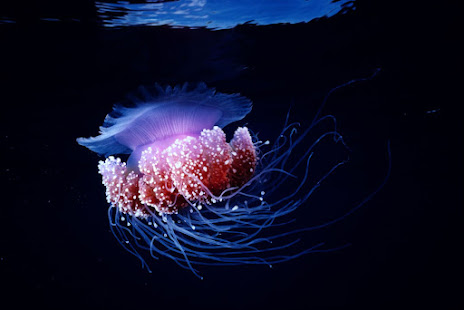Introduction
In the depths of the ocean, on moonless nights, a mesmerizing spectacle unfolds—the captivating dance of bioluminescence. This natural phenomenon, where living organisms produce and emit light, has fascinated scientists, explorers, and nature enthusiasts for centuries. From the twinkling glow of fireflies to the ethereal shimmer of deep-sea creatures, bioluminescence illuminates the night with its enchanting beauty. In this article, we will delve into the captivating world of bioluminescence, exploring its various forms, the science behind it, and its ecological significance.
The Magic of Bioluminescence
Bioluminescence is a remarkable phenomenon that occurs in various forms across the globe. It is a chemical reaction within living organisms that produces light energy. This light can manifest in different colors, from the vibrant greens and blues of marine life to the softer yellows and oranges of terrestrial organisms. Bioluminescence is not just a visual spectacle; it plays a crucial role in the survival and communication of many species.
Forms of Bioluminescence
Bioluminescence can be found in a wide range of organisms, from single-celled bacteria to complex vertebrates. Some of the most well-known examples include:
- Fireflies: These enchanting insects are famous for their mesmerizing light displays during summer nights. They use bioluminescence to attract mates and communicate with each other.
- Dinoflagellates: These microscopic algae are responsible for the sparkling displays of bioluminescence in the ocean. They emit light when disturbed, creating a magical underwater glow.
- Anglerfish: These deep-sea predators use a bioluminescent lure dangling in front of their mouths to attract prey in the dark depths of the ocean.
- Comb Jellies: These gelatinous creatures create mesmerizing displays of bioluminescence by refracting light through tiny hair-like structures called cilia.
- Glowworms: These bioluminescent insects are often found in caves and forests, where their glowing bodies illuminate the darkness.
The Science Behind Bioluminescence
The science behind bioluminescence is complex and fascinating. In most cases, it involves a chemical reaction between a light-emitting molecule called luciferin and an enzyme called luciferase. This reaction releases energy in the form of light. The specific type of luciferin and luciferase varies depending on the organism.
Several factors can influence the intensity and color of bioluminescence. These factors include the concentration of luciferin and luciferase, the pH of the environment, and the presence of other molecules that can act as enhancers or inhibitors. Scientists have been studying bioluminescence for decades, and they continue to uncover new insights into this captivating phenomenon.
Ecological Significance of Bioluminescence
Bioluminescence plays a crucial role in the ecological balance of many ecosystems. For example, in the deep ocean, where sunlight cannot penetrate, bioluminescence is a primary source of light. It allows deep-sea creatures to see, communicate, and attract prey. Bioluminescence can also be used as a defense mechanism, startling predators or attracting their predators.
In some cases, bioluminescence can even be used to create symbiotic relationships. For example, some species of squid harbor bioluminescent bacteria in specialized organs. The bacteria provide the squid with camouflage by matching the intensity and color of the surrounding light.
Human Applications of Bioluminescence
Bioluminescence has inspired numerous human applications. For example, scientists have developed bioluminescent sensors that can detect environmental pollutants or track the spread of diseases. Bioluminescence has also been used in medical imaging to visualize tumors and other biological processes.
In the field of biotechnology, researchers are exploring the use of bioluminescent proteins as markers to track gene expression and cell activity. Bioluminescence is even being used in the development of new forms of lighting that are more energy-efficient and environmentally friendly.
Bioluminescence Tourism
Bioluminescence has become a popular tourist attraction in many parts of the world. Visitors can witness the magical displays of bioluminescence by kayaking through bioluminescent bays, snorkeling with bioluminescent plankton, or exploring caves inhabited by glowworms. These experiences offer a unique opportunity to connect with nature and witness the wonders of bioluminescence firsthand.
Conclusion
The enchanting world of bioluminescence is a testament to the incredible diversity and ingenuity of life on Earth. From the depths of the ocean to the forests and fields, bioluminescence illuminates the night with its mesmerizing beauty. As scientists continue to unravel the mysteries of bioluminescence, we can look forward to even more exciting discoveries and applications of this remarkable phenomenon. Whether you are a scientist, an explorer, or simply a nature enthusiast, bioluminescence is sure to capture your imagination and leave you in awe of the wonders of the natural world.
Additional Notes
Bioluminescence is a vast and complex topic, and this article has only scratched the surface. There are many other fascinating aspects of bioluminescence that are worth exploring. For example, scientists are studying the evolution of bioluminescence, the genetic basis of this trait, and the potential for bioluminescence in other organisms. Bioluminescence is a rapidly growing field of research, and we can expect to see many more exciting discoveries in the years to come.
I hope this article has provided you with a comprehensive overview of the enchanting world of bioluminescence. If you have any questions or comments, please feel free to leave them below. Thank you for reading!






0 Comments